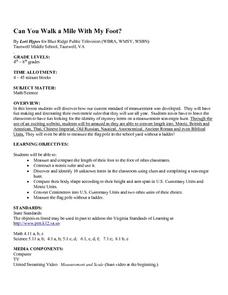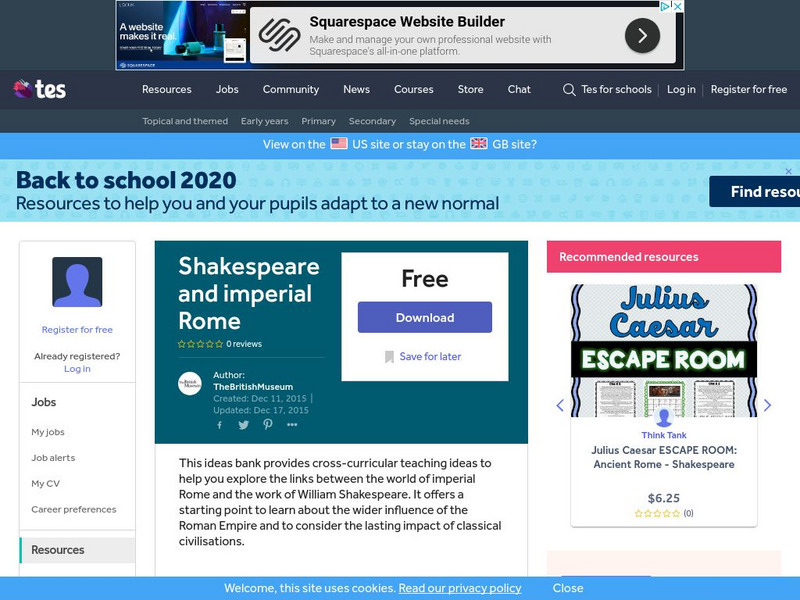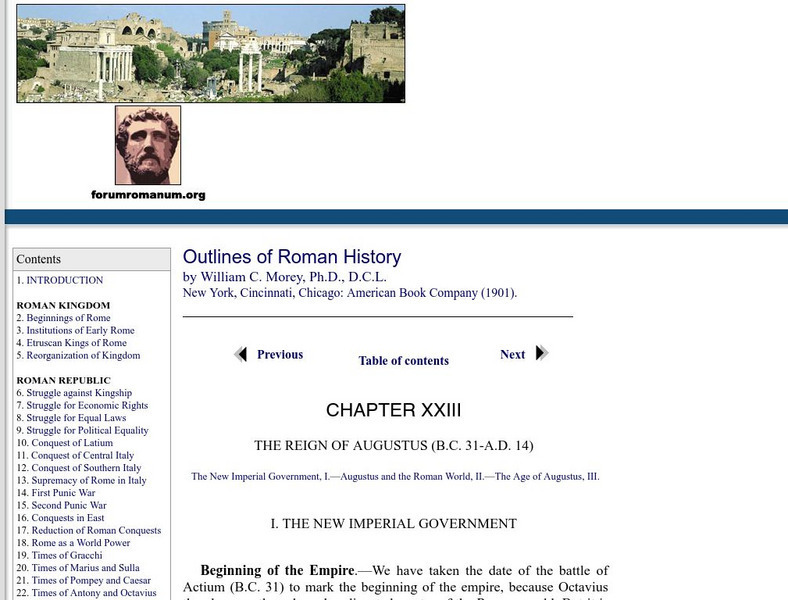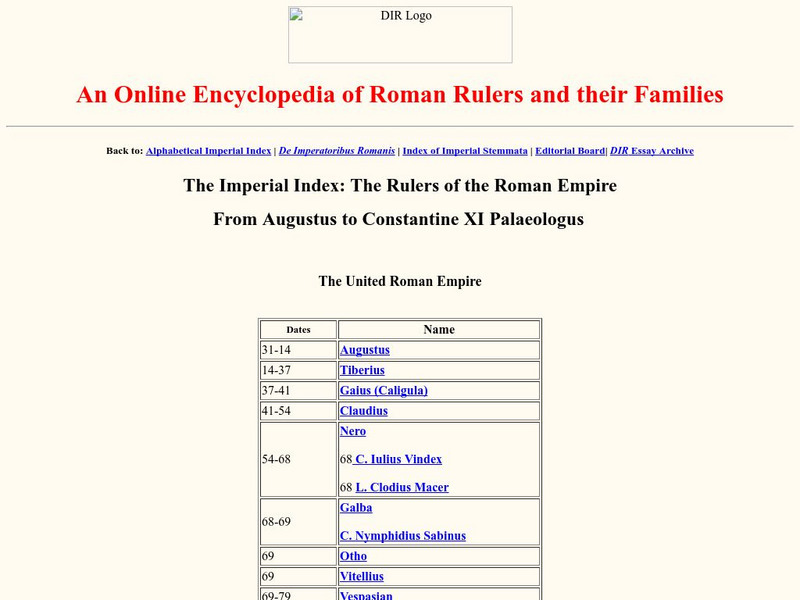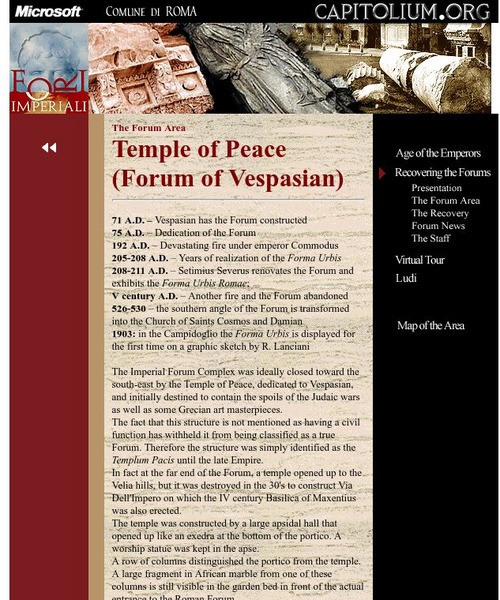Curated OER
Can You Walk a Mile With My Foot?
Young scholars engage in a lesson that is concerned with the measurement of a foot as a customary unit. They take part in a series of activities to help them acquire skills of using a foot to compare other units of measurement. The...
Curated OER
A Caravan Of Camels
Fourth graders discuss the role the Silk Road had in trade and commerce practices in China during different Chinese dynasties. The lesson plan evaluation consists of individual student writing assignments.
TES Global
Tes: Shakespeare and Imperial Rome
[Free Registration/Login Required] This ideas bank from the British Museum provides background information about Rome throughout the years and the connections to Shakespeare's works making it a good resource for cross-curricular...
Loyola University Chicago
De Imperatoribus Romanis: Alphabetical Imperial Index
This is an alphabetized, comprehensive list of Roman emperors and their families, each connected to a linked site.
Franco Cavazzi
Roman empire.net: Marcus Aurelius
Good biography of Marcus Aurelius describing the lengthy wait he had to become emperor, the fierce wars he fought, and his stoic philosophy. Also deals with the questions about Commodus and his appointments as co-emperor and emperor.
Forum Romanum
Outlines of Roman History: Augustus and the Roman World
William Morey, in his 1901 textbook, explains Augustus' administration of the three parts of the Roman Empire, Rome, Italy, and the provinces.
Loyola University Chicago
De Imperatoribus Romanis: Index
The Online Encyclopedia of Roman Emperors provides a complete list of Roman emperors. Click on the desired name to read an illustrated biographical note.
Vroma Project
V Roma Project: Augustus and Tiberius: Historical Background
This resource presents detailed information, formatted in a timeline, about Augustus and his successor, Tiberius. It features coin evidence along with genealogy charts. Click the link for the diagram and slide show that describe the...
Able Media
Ctc: I, Caesar a Study of the Imperial Romans
This lesson plan provides semester-long activities in which students research and write about selected emperors who ruled Rome during different parts of its history.
Other
Capitolium: Imperial Forums Official Website Rome
This site contains live pictures of pilgrimage sites in Rome as well as many other sites in Rome. Take the "Virtual Tour" or click on "the brief history of Rome."
The History Cat
The History Cat: Roman Gladiators
Learn all about gladiators, how to become one, the different types, the Imperial gladiatorial games, the Colosseum, and life as a gladiator.
Other
Unrv History: Roman Empire: Roman Mythology
Information about Roman mythology with links to additional information about major gods, minor gods, adopted gods, imperial cult, and more.
Forum Romanum
Outlines of Roman History: Reign of Augustus: New Imperial Government
In this passage from William Morey's 1901 textbook, he shows the changes Augustus made in the government of Rome as the empire was being established.
Khan Academy
Khan Academy: Imperial Fora
A series of public spaces in Rome called fora were built by Roman emperors and contained monumental art and architecture. View examples and read descriptions of Imperial fora built by Julius Caesar and Augustus.
Other
The Augustan Period, Vergil, and the Aeneid
Explores the relationship between the Augustan period of Roman literature, its most famous poet, and his greatest work. Provides good background to the life of Vergil and the genre of epic poetry.
Other
Imperial Fora: Temple of Peace (Forum of Vespasian)
Starting out with a timeline, the piece then moves into a complex writing of the general description, functions, historical context, and several other categories about the Temple of Vespasian. At the bottom of the page are links for...
Curated OER
Educational Technology Clearinghouse: Clip Art Etc: Roman Coin
Allocution; from an imperial Roman bronze coin in the British Museum.-Whitney, 1902
Curated OER
Eternal Egypt: Small Roman Style Balance
The small hand balance was used for small, accurate weighing. The balance is in the Imperial Roman style with an indicator, whose sides are ornamented in the shape of a rosary.
Curated OER
Educational Technology Clearinghouse: Clip Art Etc: A Roman Legionary
From a monument of the imperial age. The soldier wears a metal helmet, a leather doublet with shoulder-pieces, a metal-plated belt, and a sword hanging from a strap thrown over the left shoulder. His left hand holds a large shield, his...
Lonely Planet
Lonely Planet: Libya History
This site from Lonely Planet provides an overview of Libyan history from the Roman invasion in the 2nd century to modern day. It includes a section on Italian/Turkish conflict and the struggle for control of the region.
Khan Academy
Khan Academy: Forum and Markets of Trajan
Marcus Ulpius Traianus, now commonly referred to as Trajan, reigned as Romess emperor from 98 until 117 C.E. and had a reputation as a good emporer. A massive architectural complex-referred to as the Forum of Trajan was devoted to...
Art Institute of Chicago
Art Institute of Chicago: Art Access: Roccoco to Realism
From the early 18th to the mid-19th century, dynamic transformations in European art mirrored turbulent political and social changes, including revolutions, imperial conquests, and the emergence of the modern industrial age....
Khan Academy
Khan Academy: World History: 600 Bce 600 Ce Second Wave Civilizations
We have 2 resources from here but should be cross-checked against embedded videos.


